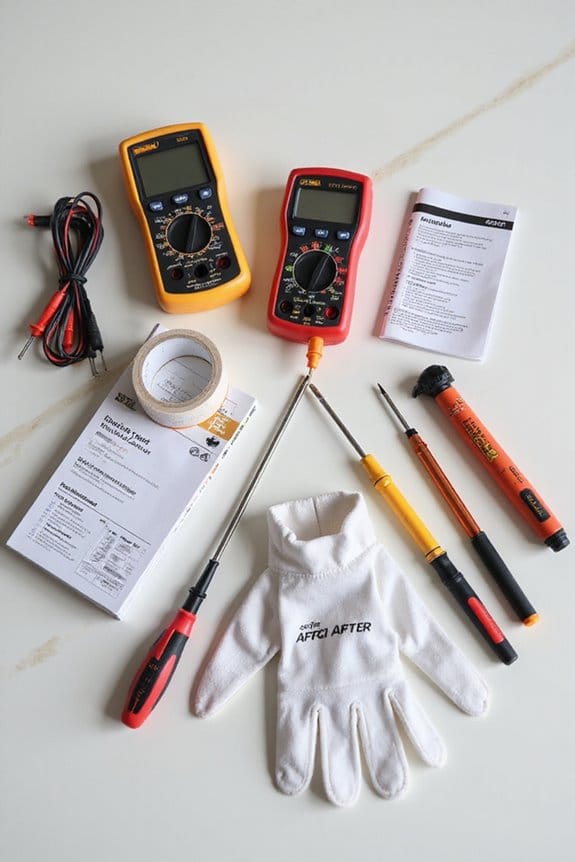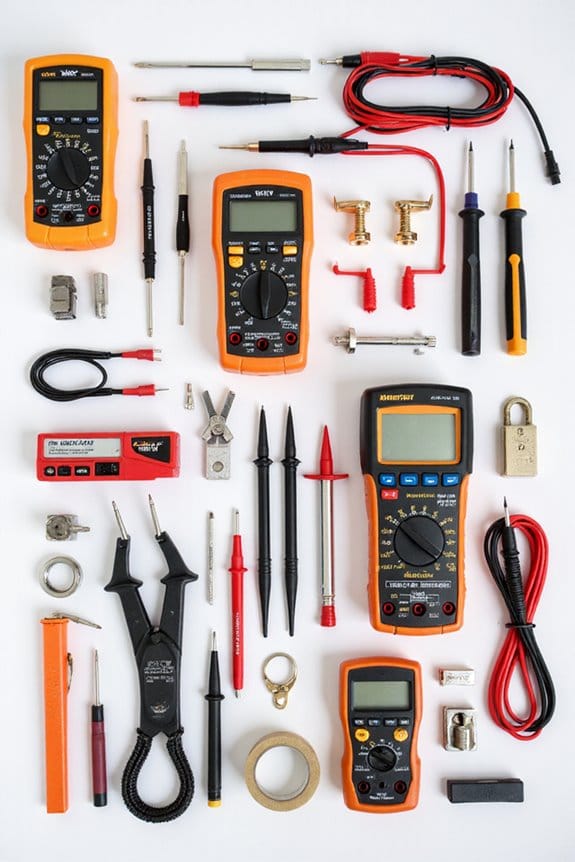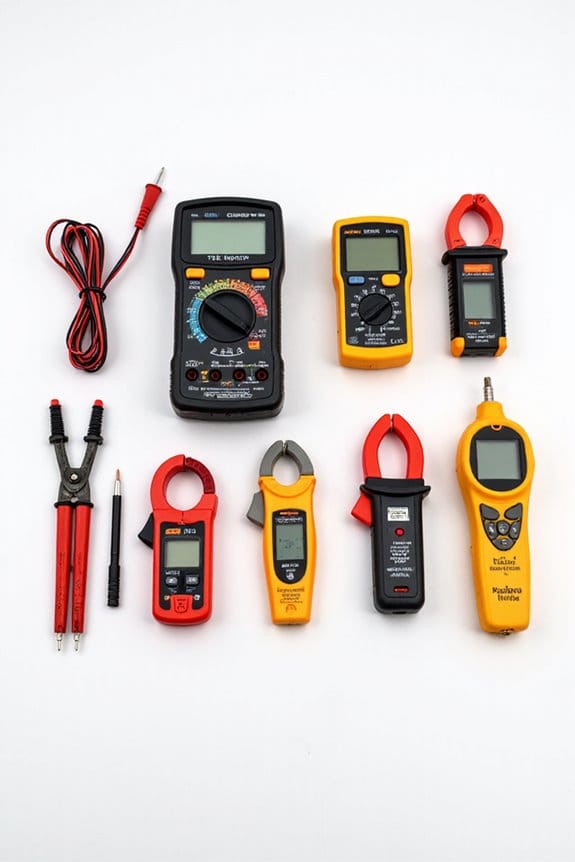To test AFCI circuit breakers, follow these steps: 1) Verify the power is ON and the breaker is set to ON; use insulated tools, please! 2) Press the TEST button—it should trip right away. 3) Disconnect all loads and reconnect them one by one. 4) Retest with the TEST button after reconnecting for consistent performance. Regular testing is key to keeping your home safe from arc faults. Stick around for more insights on maintaining those breakers!
Key Takeaways
- Ensure the AFCI breaker is powered ON and in the ON position before testing.
- Press the TEST button; the breaker should trip immediately if functioning properly.
- Disconnect all loads, reconnect them one at a time, and observe for specific issues.
- Retest the breaker using the TEST button after restoring loads to confirm consistent operation.
- Document any recurring problems and consult a professional if issues persist.
Understanding AFCI Circuit Breakers
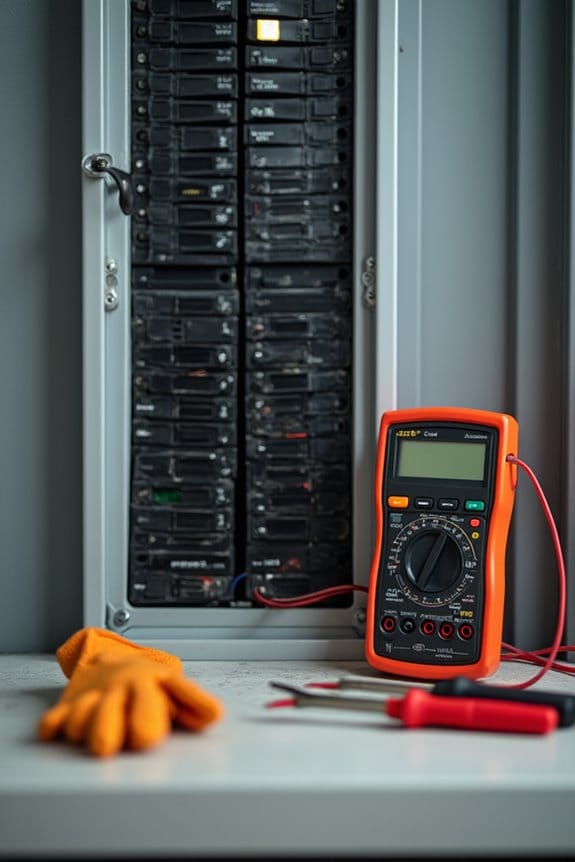
When it comes to home safety, AFCI circuit breakers are like the superheroes of your electrical system. Their AFCI functionality is essential, as they protect against dangerous electrical arcing faults that can ignite fires. Here’s how they work:
- Arcing Detection: AFCIs continuously monitor currents, looking for high-frequency signals that indicate arcing.
- Types of Arcing: They detect both parallel and series arcs, which can occur between conductors or within a single wire.
- Immediate Action: When a hazardous arc is identified, the AFCI quickly opens the circuit, stopping the current flow.
These little champions are a must-have, especially in bedrooms, where we spend so much time. Trust me, investing in AFCIs is like adding a fire extinguisher to your home’s electrical system—smart and safe!
Importance of Monthly Testing

Monthly testing of AFCI circuit breakers isn’t just a good idea—it’s essential for safety. It guarantees that your breakers are operational and can effectively detect arc faults, which can lead to electrical fires. Here’s why monthly compliance is a must:
- Fire Prevention: Regular testing helps verify that breakers trip when needed, preventing potential fire hazards.
- Early Detection: It identifies degraded or failed breakers before they become a problem.
- Insurance and Code Compliance: Keeping up with testing supports homeowners’ insurance requirements and adheres to electrical safety standards.
Step-by-Step Testing Procedure
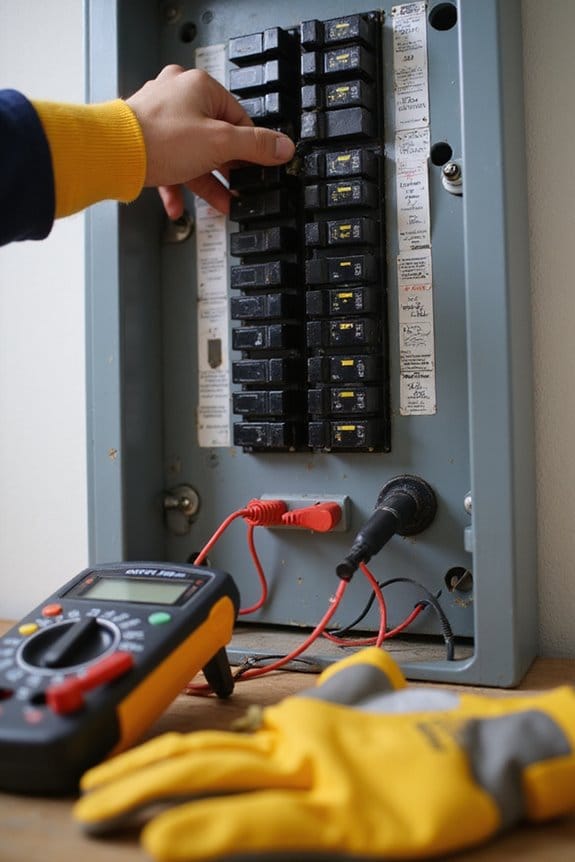
Testing AFCI circuit breakers can seem challenging, but it’s really just a straightforward process anyone can handle with a little guidance. Here’s a simple step-by-step procedure:
- Safety First: Make certain power is ON and the breaker’s in the ON position. Use insulated tools and wear protective gear.
- Test Functionality: Press the TEST button on the AFCI breaker. It should trip immediately. If it doesn’t, consider replacement.
- Load Inspection: Disconnect all loads and reconnect them one at a time. Check if the breaker trips with any specific load—this helps assess AFCI functionality.
- Final Checks: Once loads are restored, retest using the TEST button. This keeps your testing frequency consistent and guarantees everything’s working well. Additionally, ensure that your testing procedure complies with safety compliance standards to enhance overall electrical safety.
Troubleshooting Common Issues
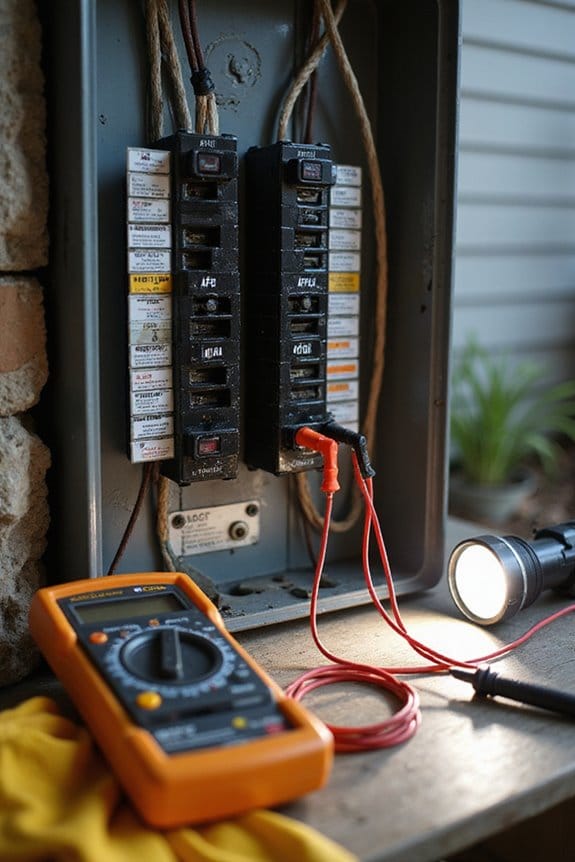
Troubleshooting common issues with AFCI circuit breakers can feel a bit intimidating, but I promise it’s manageable once you know what to look for. Here are a few tips:
- Appliance Compatibility: Some devices like microwaves and treadmills can cause AFCI trips due to their mechanical arcs. Unplug them and see if the breaker holds.
- Wiring Issues: Check for loose connections or damaged insulation. These can lead to irregular arcing that trips the breaker.
- Overload: Running too many high-demand devices at once can overload the circuit. Try unplugging everything and reintroducing devices one at a time.
If you’re still having issues, don’t hesitate to contact the manufacturer for specific load info. Happy troubleshooting!
Safety Considerations During Testing
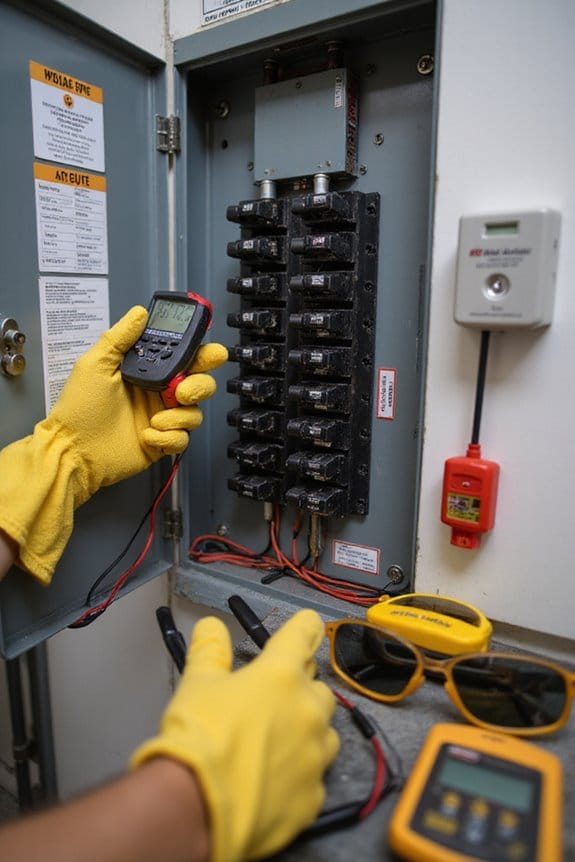
When you’re gearing up to test AFCI circuit breakers, safety should be your top priority—after all, a little caution goes a long way! Here are a few key safety considerations to keep in mind:
- Labeling and Accessibility: Make sure the AFCI breaker is clearly labeled and easy to reach.
- Disconnect Loads: Remove non-essential electrical loads to prevent nuisance tripping during testing.
- De-energize the Panel: Always verify that the panel is de-energized before starting.
- Use PPE: Wear appropriate personal protective equipment and use insulated tools.
- Lockout/Tagout: Implement lockout/tagout procedures to prevent accidental re-energization.
When to Call a Professional
While it might be tempting to tackle every electrical issue yourself, there are definitely times when calling a professional is the best course of action. Here are some key situations:
- Failed Test Button: If your AFCI breaker doesn’t trip when you press the test button, it’s time for a professional evaluation.
- Frequent Tripping: Breakers that trip without apparent cause need expert diagnosis to prevent electrical hazards.
- Visible Damage: Any signs of burning or damage require immediate attention from an electrician.
- Complex Troubleshooting: If the breaker trips intermittently, advanced tools and expertise are essential.
- Code Compliance: When in doubt about electrical codes, consulting with a professional is a smart move.
Trust me, it’s better to be safe than sorry!
Maintaining AFCI Breakers for Longevity
Maintaining AFCI breakers is essential for ensuring their longevity and effectiveness, especially since they play a key role in preventing electrical fires. Here are some tips I’ve found helpful:
- Visual Inspections: Regularly check for physical damage, loose connections, or signs of overheating. If it looks off, it probably is!
- Cleaning: Use high-pressure air to clear dust and contaminants. Keep those contacts clean; it makes a difference!
- Functional Testing: Don’t forget to press that test button monthly. It’s like a routine gym check, but for your breaker.
- Circuit Monitoring: Keep an eye out for nuisance tripping. If it trips often, investigate the circuit.
Frequently Asked Questions
Can AFCI Breakers Be Tested Without Turning off the Main Power?
Yes, I can confirm AFCI testing can be done without turning off the main power. By pressing the TEST button, I verify the breaker functionality, ensuring it trips properly and maintains safety standards.
What Is the Lifespan of an AFCI Circuit Breaker?
Did you know AFCI circuit breakers typically last 30 to 40 years? I’ve learned that proper breaker maintenance is essential for maximizing AFCI longevity, as environmental factors and frequent tripping can greatly shorten their lifespan.
Are There Specific Brands of AFCI Breakers Recommended for Safety?
When considering AFCI brands, I always check their safety ratings. Siemens, Eaton, and Schneider Electric consistently stand out for reliability and performance. Choosing reputable brands guarantees better protection against electrical hazards in my home.
Can I Use a Multimeter to Test an AFCI Breaker?
I wouldn’t rely solely on multimeter usage to test an AFCI breaker’s functionality. While it checks continuity, it can’t confirm arc fault detection. Always press the TEST button for accurate testing and safety assurance.
What Should I Do if My AFCI Breaker Won’T Reset?
If your AFCI breaker won’t reset, it’s like a stubborn door refusing to open. I’d recommend some troubleshooting tips first; if those fail, consider a breaker replacement to restore your home’s electrical harmony.

